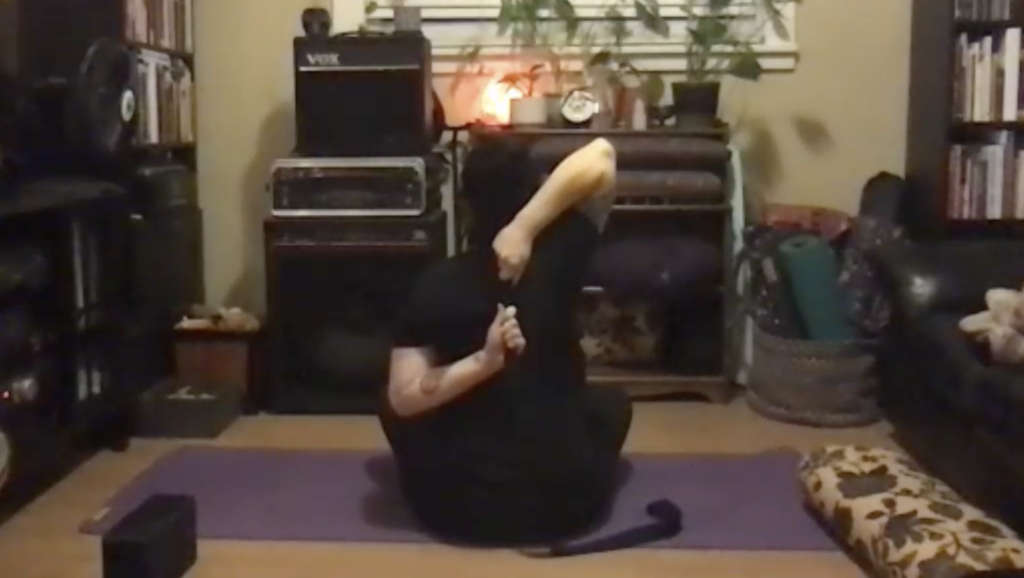
Gomukhasana (Cow Face Pose) is a staple in my morning yoga classes. Years ago, several of my students made up unflattering names for it—Cow Pie, Mad Cow, etc.—because it was so challenging for them. Now those same Cow Face naysayers have turned into Cow Face converts, even sometimes giving up a bit of their Savasana to do it if I don’t offer it in class. The Cow Face arm position is another story, however. It can be quite a challenge, but with a yoga strap, anyone can reap the benefits.
Gomukhasana is quite complex. It’s classified as a hip opening pose, as it stretches all the glutes—maximus, medius and minimus—as well as the piriformis and the tensor fasciae latae. My students—the ones who like it—find it very grounding, making it helpful a helpful pose toward the end of a practice. (Note that the photo that accompanies this blog shows only the arm position, not the leg position. You can find a description of the leg position in the above “Gomukhasana” link.)
Cow Face Pose also opens the shoulders. The classic arm position, with one elbow pointing upward and the other forearm wedged behind your shoulder blades—said to look like one raised and one lowered ear on a cow’s head—creates a strong triceps stretch in the upper arm and a strong biceps and deltoid stretch in the lower one.
While the leg and arm positions are traditionally practiced together, they can also be beneficial on their own if you’re interested in putting more attention into either your hips or shoulders.
Gomukhasana Arms
Today’s blog will focus on the shoulders. While the traditional position calls for connecting the hands of your upper and lower arms in the upper back, reality is, many people’s shoulders just won’t allow this. There are many possible reasons for this, including the construction of the shoulder joints. Some people’s shoulders are formed for stability. They may not be able to reach their elbow straight up toward the sky because their humerus bones will “hit” the back of the scapula before the arm gets to vertical. This is within the normal variations in range of motion.
Others will find that when their dominant arm is the lower one, that their hands can’t touch, even though they may connect when the dominant arm is the upper one. This is probably due to increased strength and stability in the dominant arm’s biceps and deltoids. Or there could be some other reason.
In any case, a yoga strap can help. It can bridge the gap between your hands, creating a connection. Connecting the hands is important for energizing the arms in Gomukhasana. Whether you connect the fingers or use a Yoga Strap to connect the hands, your Gomukhasana will be more dynamic if you can connect your hands.
How to Use a Yoga Strap in Gomukhasana
If your hands don’t connect in Gomukhasana, try this:
- Extend your left arm out in front of you, turning your palm outward. Swing your arm around behind your back. Bend your elbow and place the back of your hand on your low back. Now scoot your hand up your spine any amount—anywhere from the lower ribcage to between the shoulder blades.
- Hold a Yoga Strap in your right hand. Dangle it over your back. Turn your right palm to face inward, toward your head. Bend your elbow and find the yoga strap with your left hand. Walk your right and left hands toward each other. If you’d like to add some extra energy to your shoulder experience, “stretch” the strap, pulling upward with your right hand and downward with your left.
- Stay for five to ten deep breaths. Let go and let your arms relax. Take five to ten deep breaths before practicing your other side.
If you’d like to see more uses for Yoga Straps, as well as how to use Hugger Mugger’s other premium props, please visit the Yoga Props Guide.
